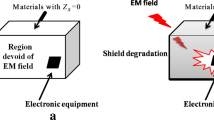Abstract
When large structures such as residential compounds or public buildings are under the influence of extremely low frequency (ELF) magnetic fields, such as the one generated by a system of railways fed by 16.67 Hz, standard methods of designing shielding structures by numerical methods usually fail. The latter can be explained by the difficulty posed in the computing process by the large aspect ratios involved due to thin layers of metal (a few millimetres or centimetres) in contrast to the large dimensions of the affected structure (several tens of meters). In some cases one has to utilize special approximations such as surface conductivity, which are not easy to handle when the designed shielding structure is clearly three -dimensional. Other alternatives such as experimentation in situ are very costly. Here, a new technique is presented of mitigating the field by using three-dimensional propagation of induced currents optimizing the field reduction factors and minimizing the cost of shielding material. The particular designing method is a hybrid of numerical simulations combined with lab experimentation using scaled models of the large structure. The method is rather cost-effective and flexible as various designs can be easily tested. Results are presented in the form of magnetic field values, at various locations in the buildings, before and after this mitigation technique is applied.
Similar content being viewed by others
References
Buccella, C., Feliziani, M., Maradei, F., & Manzi, G. (2004). Evaluation of the magnetic field levels produced by a railway line, Proceedings of conf. Environmental Modelling and Simulation. ref. 432.
Chadwick, P., et al. (1998). Magnetic fields on British trains. Annals of Occupational Hygeine, 5, 331–335.
Comsol AB, Femlab 3.1. (2004). Electromagnetics Module User’s Guide. Sweden.
ICNIRP. (1998). Guidelines for limiting exposure to time-varying electric, magnetic and electromagnetic fields (up to 300 GHz). Health Physics, 74(4), 494–522.
Information Ventures, Inc. Electromagnetic fields and rail maintenance workers: Final report of an exposure survey and feasibility investigation. Exposure assessment, http://infoventures.com, 1999.
International Commission on Non-Ionizing Radiation Protection (ICNIRP) (2003) Guidance on determining compliance of exposure to pulsed and complex non-sinusoidal waveforms below 100 kHz with ICNIRP guidelines, 84, 383–387.
Minder, C. E., & Pfluger, D. H. (2001) Leukemia, brain tumors and exposure to extremely low frequency of electromagnetic fields in Swiss railway employees. American Journal of Epidemiology, 153(9), 825–835.
Opera 3d User manual solver ELEKTRA. (1996). Vector Fields Ltd.
Röösli, M., Lörtscher, M., Pfluger, D. & Schreier, N. (2005). ELF (16.7 Hz) magnetic field exposure assessment in Swiss railway engineers. Bioelectromagnetics, Dublin, Ireland–Book of abstracts pp. 41–42.
Rossi, P., Falsaperla, R., Brugaletta, V., Betti, P. & Gaggelli, A. (2003). Occupational exposure to static and ELF magnetic fields on railway engines. VI International Congress of the European BioElectromagnetics Association, EBEA 2003. Budapest Nov. 13–15, p.31.
Salinas, E., Liu, Y. Q., Souza, P. Jr., Atalaya, J., Cruz, P., & Daalder, J. (2005). Design and validation of power-frequency magnetic field conductive shielding for underground cables Proceedings of CIRED’2005, 18th International Conference and on Electricity Distribution, IEE Technical Report, Technical Theme 2, Power Quality and EMC, paper 97 pp. 1–4, Turin.
Salinas, E., Pettersson, P., Daalder, J., Liu, Y., Atalaya, J., Gonzales, D., Jassi, M., Contreras, C., & Leon, C. (2006). Minimization of power-frequency magnetic fields in confined regions using 3-dimensional physical processes; with applications to currently active electrical substations, ELFORSK Report, project 3950.
Acknowledgements
The authors are grateful to the representatives of the Swedish company NCC AB for proposing the problem and support. Also to O. Ivarsson for performing the measurement in Fig. 3. We would like to thank the Faculty of Science of the Universidad Nacional de Ingeniería, in Lima Peru, for allowing us to use of their lab facilities. Our gratitude also goes to ELFORSK for the grant No 3950, which enabled us the development of some the methods used in this study.
Author information
Authors and Affiliations
Corresponding author
Rights and permissions
About this article
Cite this article
Salinas, E., Atalaya, J., Hamnerius, Y. et al. A new technique for reducing extremely low frequency magnetic field emissions affecting large building structures. Environmentalist 27, 571–576 (2007). https://doi.org/10.1007/s10669-007-9061-4
Published:
Issue Date:
DOI: https://doi.org/10.1007/s10669-007-9061-4




